
We continue to look at the fallout from the Fukushima Daiichi Nuclear Power Plant crisis in 2011 with a documentary about the former residents of Futaba, where the facility is located. “Nuclear Nation: The Fukushima Refugees Story” follows them in the first year after the disaster as they live communally in an abandoned school near Tokyo. Many mourn the loss of family members and their homes, and worry about the impact of radiation exposure on their health. We play excerpts from the film and are joined by director Atsushi Funahashi.
Transcript
AMY GOODMAN: “Love Me Tender,” covered by RC Succession. The popular Japanese band rewrote the classic song’s lyrics to be about opposition to nuclear power here in Japan. Yes, we are broadcasting from Tokyo, Japan, for the next three—two days, three days altogether. This is Democracy Now!, democracynow.org, The War and Peace Report. I’m Amy Goodman, as we continue to look at the fallout from the Fukushima Daiichi Nuclear Power Plant meltdown, turning to a documentary called Nuclear Nation: The Fukushima Refugees Story. The film looks at what happened to residents of the town of Futaba, where the plant was located. In a minute, we’ll be joined by the director of this film, Atsushi Funahashi, but first, a clip from Nuclear Nation that takes us to meet the former residents of Futaba who were forced to leave their homes, possibly permanently. In this scene, the evacuees are staying in an abandoned school near Tokyo.
MARC CARPENTIER, Narrator: Spring. The residents of Futaba left behind their hometown, beleaguered by a crippled nuclear power plant. More than 1,400 refugees now live here. It’s a school near Tokyo that’s been transformed into a modern-day Noah’s Ark for those escaping radiation. Futaba hosts Fukushima Daiichi. After the accident, the townspeople fled 250 kilometers to the outskirts of Tokyo. The Japanese government is providing three boxed lunches a day.
FOOD WORKER: [translated] How many? Three. Here you are. Sorry for the wait. How many for you? Two? OK, here you are. Thank you. How many for you, sir? Three. OK, three. There you go. Please help yourself to the cucumbers.
GIRL: [translated] It’s rice gruel. For Grandma.
INTERVIEWER: [translated] It’s for Grandma?
GIRL: [translated] Because we have Grandma.
INTERVIEWER: [translated] That’s nice.
GIRL 1: [translated] Come on. [in English] Bye!
MARC CARPENTIER: Ten to 20 people occupy each classroom.
FEMALE EVACUEE: [translated] Oh, my legs. What’s this called? Eh? Bibimbap?
MALE EVACUEE: [translated] All that was left of our house was the concrete foundation. Terrible. It was all swept away. From relatives to friends. All the cremations are over.
INTERVIEWER: [translated] Is that right? What a shame.
FEMALE EVACUEE: [translated] Even babies and kids.
MALE EVACUEE: [translated] About 200 people from our community died. And 100 of those bodies haven’t been identified. We lost a lot of relatives.
AMY GOODMAN: That’s a clip from Nuclear Nation: The Fukushima Refugees Story. And we’re joined here in our Tokyo studio by its director, Atsushi Funahashi.
Welcome to Democracy Now! It’s great to have you with us. I watched the film on the plane as I was flying to Japan. It is a powerful film about nuclear refugees.
ATSUSHI FUNAHASHI: Yeah, thank you for having me, Amy. Yeah, so how did you like the film?
AMY GOODMAN: I mean, it’s an astounding film, because you have this entire town, Futaba—
ATSUSHI FUNAHASHI: Yeah.
AMY GOODMAN: —that was completely relocated into a school. Explain how this happened.
ATSUSHI FUNAHASHI: It was—the entire Japan was pretty much confused right after this accident happened. First of all, the Japanese government ordered evacuation, a three-kilometer radius from ground zero, from Fukushima Daiichi, then 10-kilometer, then 20-kilometer. It is back, March 2011. Then the American government, actually, made an advisory to the American people staying in Japan to stay away at least 50 miles, and which is 80 kilometers. So, Japanese people started arguing, why the Americans goes 80 kilometer, then Japanese go 20. And so, there was a huge confusion that—how far you have to get away from it.
Then, at the end of March, I heard this small town of Futaba evacuated 250 kilometers from the Fukushima Daiichi, because nobody knew how far you should go escape. So I thought that was the right decision, and that’s why I kind of try to focus on this small town. And first of all, all the town, except Futaba, stayed inside of the Fukushima prefecture, close—relatively closer to this Fukushima Daiichi. Then, this was the only town, and that this is the—this town escaped farthermost. And I thought this could be the very—you know, interesting, and it’s meaningful, too.
AMY GOODMAN: You didn’t have permission to go and film back in Fukushima, but you got a permit from one of the family members, because each family was given two permits to return for two hours to get their things if they wanted to.
ATSUSHI FUNAHASHI: Yes, yes. I tried to negotiate with the government, and they didn’t give me any permission to go inside there. And any other independent journalist or documentary filmmakers didn’t get the permission to go inside. But I got along very well with this family from Futaba, and they gave me—”OK, maybe we go back in there, and then we got four permits, and then we are just using two, so why don’t we come together?”
AMY GOODMAN: I want to turn to another clip from your film, Nuclear Nation. This is Masami Yoshizawa, a cattle farmer who defied evacuation orders after the Fukushima disaster.
MASAMI YOSHIZAWA: [translated] I can’t sell these cows. Keeping them, feeding them, and incurring expenses, what’s the use in that? I was conflicted. But my mind’s made up. I’m committed to letting these cows live. My destiny is linked with theirs.
MARC CARPENTIER: Most farmers, however, have obeyed the evacuation order and have deserted their animals. Without food or water, the cows were left to die. Out of 3,500 head of cattle within the evacuation zone, about half have starved to death.
AMY GOODMAN: That’s a clip from Nuclear Nation. And before we get the filmmaker’s comments, I wanted to play one more clip. In August 2011, municipalities hosting nuclear plants from across Japan convened in Tokyo to lobby the government after the Fukushima Daiichi nuclear disaster. We’ll hear from the nuclear crisis minister, Goshi Hosono, but first, this is Banri Kaieda, minister of economy, trade and industry. The clip ends with a comment by a representative from the town of Futaba, which was evacuated after the disaster—the mayor there.
BANRI KAIEDA: [translated] The future of energy production and Japanese energy policy is currently being debated, and this is something we’ve communicated to you. Regarding the details of this review, I believe it’s important to clearly define the terms as soon as possible. Thank you very much.
MARC CARPENTIER: The industry minister leaves his seat in the first five minutes.
GOSHI HOSONO: [translated] The central and prefectural governments are working on the annual health check guidelines. Based on what we’ve researched until now, the impact of radiation on children appears negligible. However, we will endeavor to keep you apprised of any developments.
MARC CARPENTIER: The nuclear crisis minister follows suit, citing official duties.
CHAIRPERSON: [translated] And now, we’d like to open the floor for comments. Please raise your hands. OK, go ahead.
MAYOR KATSUTAKA IDOGAWA: [translated] I’m representing Futaba. I want to know why we’re being made to feel this way. It’s frustrating. What does the nuclear power committee think? When you came and explained it to us, you lied, saying it was safe and secure. But we, who trusted and believed you, can no longer live in our own town.
AMY GOODMAN: That was the mayor of Futaba. Again, this entire town, now a town of nuclear refugees, cannot go home.
ATSUSHI FUNAHASHI: Right.
AMY GOODMAN: And what is the prospects for them ever returning?
ATSUSHI FUNAHASHI: There’s none, pretty much. The only thing the government is saying is that at least six years from the accident, you cannot go back to your own town. But they don’t give you any other prospect after that. That’s the fundamental problem they have. They are giving out all those compensation up to the six years from the accident, but they don’t give you any prospect. When you compare it to, this compensation, with, let’s say, some public projects, like making highways or dam, they compensate you entire land and the house you live in, because you have to move away. But what’s happening in Fukushima is that it’s about 40 percent, when you compare with those highway or the public projects, so—because the difference is that the government is saying, for the nuclear refugees, your—the basic assumption is that you are going back there. And for the highways and the dam, you’re not going back.
AMY GOODMAN: Although they can’t, for years.
ATSUSHI FUNAHASHI: They can’t, right.
AMY GOODMAN: I want to thank you for being with us, Atsushi Funahashi, director of Nuclear Nation: The Fukushima Refugees Story. He is now working on Nuclear Nation part two. And that ends it for the broadcast. On Saturday, January 18th, I’ll be speaking in Tokyo here at Sophia University at 10:00 a.m. at the International Conference Room, #2 Building. Then, Sunday the 19th, 7:00 p.m., I’ll be speaking in Kyoto. You can check our website at democracynow.org. And then on Monday at the Japanese Correspondents Association here in Tokyo.

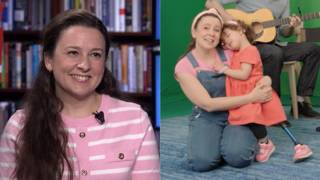
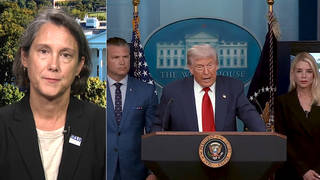
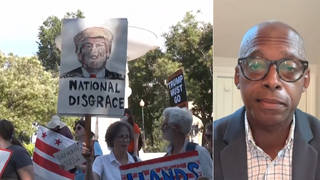
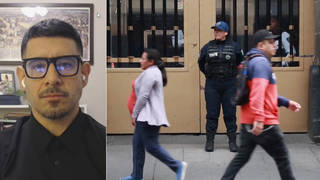

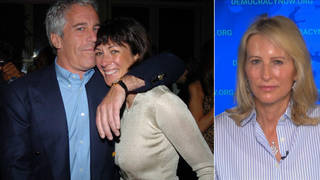
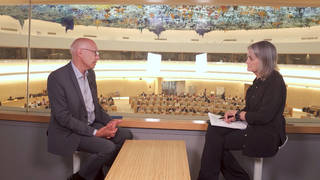
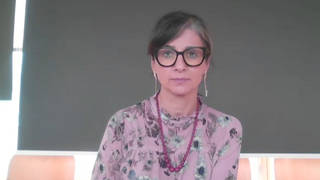

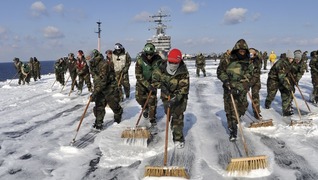

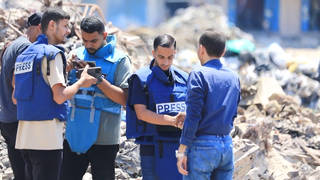
Media Options